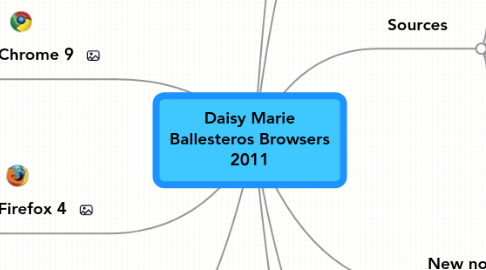
1. Google Chrome 9
1.1. Pros:
1.1.1. Chrome is the first mainstream browser to support WebGL, but it should also be available in Firefox 4.0 and IE9. Definitely a technology to watch.
1.1.2. Instant works on both search and web pages
1.2. Cons:
1.2.1. Sometimes pages fail to load properly or at all
1.2.2. Google Instant is not activated by defaul
2. Mozilla Firefox 4
2.1. Pros:
2.1.1. Support for HTML5 and CSS3
2.1.2. Interface design
2.2. Cons:
2.2.1. Heavy on resources
2.2.2. Add-ons may not work with this release
3. Explorer9
3.1. Pros:
3.1.1. Minimalist interface leaves more room for webpages.
3.1.2. Many security features.
3.2. Cons:
3.2.1. Only works in Windows 7 and Vista
3.2.2. Absence of an inline spell check
4. Define: Browser
4.1. A software application for retrieving, presenting, and traversing information resources on the World Wide Web. An information resource is identified by a Uniform Resource Identifier (URI) and may be a web page, image, video, or other piece of content
5. Define: HTML5
5.1. Pros:
5.2. Made it much easier to make documents declaration
5.3. Has the potential to change the way websites are created
5.4. Cons:
5.5. HTML5 language is not fully developed
5.6. can be inaccurate, if locations chages
6. Sources
6.1. Minimum 5 sources, only most recent versions as shown:
6.1.1. Shorten your URLs at the following link:
6.1.2. http://bit.ly/
6.2. http://tinyurl.com/nfwt8a
6.3. http://tinyurl.com/3kxjp5a
6.4. http://tinyurl.com/oayo2r
6.5. http://tinyurl.com/3jupowd tp:
7. Apple Safari 5
7.1. Pros:
7.1.1. Ast JavaScript performance. Built-in RSS reader.
7.1.2. Good standards support. Great tab implementation.
7.2. Cons:
7.2.1. No extensions available yet. No themes
7.2.2. Split process model, very much like Google has in Chrome but at the core of
8. Opera 11
8.1. Pros:
8.1.1. Incredibly fast
8.1.2. Tab stacks
8.2. Cons:
8.2.1. Fewer extensions than other browsers
8.2.2. Growl and multitouch trackpad support on Macs
